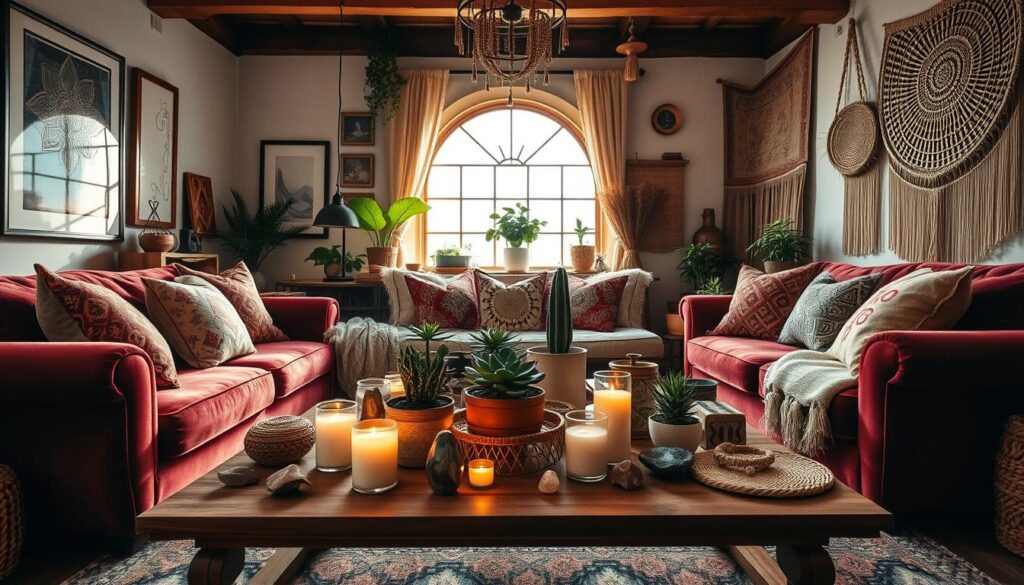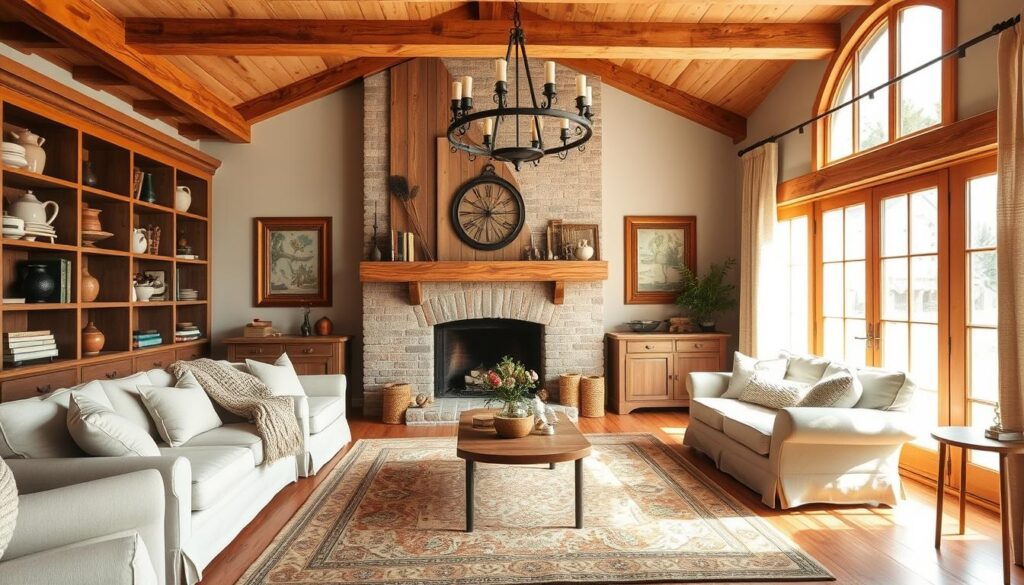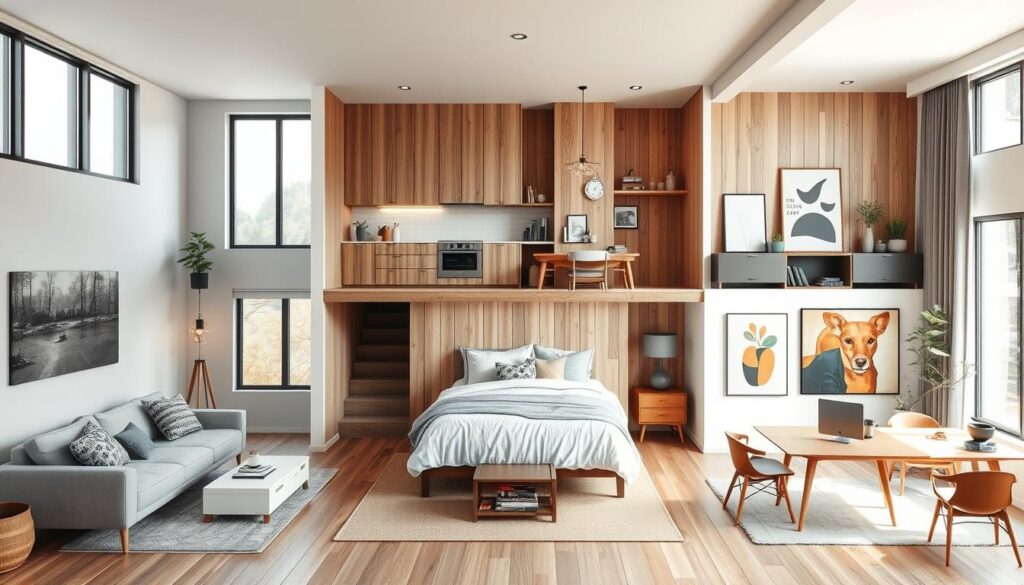Did you know the right interior design style can boost your home’s value by up to 15%? With many popular interior design styles out there, picking the right one can feel daunting.
In our journey through home interior design, we’ll look at different styles that can turn a house into a home. We’ll talk about why choosing the right style matters and offer tips on picking the best design for your space.
Key Takeaways
- Discover the most popular home interior design styles
- Learn how to choose the right style for your living space
- Understand the importance of interior design in increasing property value
- Get guidance on how to select the perfect design for your home
- Explore the various styles that can transform a house into a home
Understanding Home Interior Design Styles
Knowing about home interior design styles is key for homeowners. It helps in creating a space that looks good and works well. With many styles out there, picking the right one can be tough.
What Are Home Interior Design Styles?
Home interior design styles are about the look and feel of a space. They come from culture, personal taste, and history. Styles like modern, traditional, and rustic each have their own special touches.
Modern interior design trends are all about clean lines and less decoration. They focus on being useful. In contrast, classic home decor ideas use traditional furniture and rich colors.
Importance of Choosing the Right Style
Picking the right style is crucial. It affects how your home feels and works. A good style makes your home feel like a true home, showing off your personality.
“The right interior design style can transform a house into a home, making it a reflection of the occupants’ personalities and tastes.”
Think about your lifestyle, what you like, and your home’s design when choosing a style. Also, consider how you’ll use each room and the mood you want to set.
| Style | Key Elements | Ideal For |
|---|---|---|
| Modern | Sleek lines, minimal ornamentation, functional | Those who prefer a clean and minimalist look |
| Traditional | Classic furniture, rich colors, ornate details | Those who appreciate classic elegance and sophistication |
| Rustic | Natural materials, cozy atmosphere, vintage elements | Those who want a warm and inviting home |
By learning about different styles, you can pick one that fits your needs and taste.
Popular Home Interior Design Styles
Choosing a home interior design style can really change how your space feels. There are many styles to pick from, making it hard to decide. We’ll look at some top styles like modern, traditional, and rustic.
Modern: Sleek and Minimalistic
Modern design is all about being sleek and simple. It uses clean lines, few decorations, and focuses on being useful. To go modern, pick neutral colors, use industrial materials, and keep things tidy.
Key elements of modern design include:
- Clean lines and minimal ornamentation
- Neutral color palette
- Industrial materials such as steel and glass
Traditional: Timeless Elegance
Traditional design is known for its classic beauty and comfort. It uses rich colors, detailed designs, and cozy furniture. To add traditional style, use warm colors, choose classic furniture, and add fancy details like molding.
Characteristics of traditional design include:
- Rich, warm colors
- Ornate details and classic furniture
- Comfortable, inviting furnishings
Rustic: Cozy and Warm
Rustic design aims to make your space feel cozy and welcoming. It uses natural materials, earthy tones, and old or antique items. For a rustic look, use wood and stone, pick earthy colors, and add vintage or antique pieces.
Elements of rustic design include:
- Natural materials such as wood and stone
- Earthy colors and vintage or antique pieces
- Cozy, inviting furnishings
These popular styles offer many ways to make a space that shows your personality and meets your needs. Whether you like the modern look or the rustic feel, there’s a style for you.
Exploring Contemporary Design
Contemporary design focuses on clean lines, minimal decor, and function. It’s not just about looks; it’s about making spaces useful and comfy.
Many think contemporary and modern design are the same. But they’re not. Modern design is from the early to mid-20th century, strict in its rules. Contemporary design is more flexible, showing today’s trends and tastes.
Key Characteristics of Contemporary Style
Contemporary design loves simplicity and minimalism. It uses clean lines, little decor, and puts function first. Spaces often have open layouts, big windows, and simple colors.
- Clean lines and minimal ornamentation
- Emphasis on functionality
- Open floor plans
- Large windows for natural light
- Neutral color palette
Adding contemporary design to your home means using traditional interior decorating tips for simplicity and elegance. Start with a neutral base and add color with furniture and decor for a modern look.
Color Palettes and Textures
Contemporary design often uses neutral colors like white, gray, and beige. These colors are calm and let bold pieces stand out. Textures add depth and interest. Mixing smooth, rough, and soft textures creates a rich look.
To make your home look stylish, mix different textures and materials. For example, metal and wood together can make a space warm and classy.
Some top textures in contemporary design are:
- Smooth surfaces like glass and metal
- Rough-hewn wood
- Soft fabrics such as velvet and linen
- Natural stone
By following these principles, you can make a contemporary space that’s both stylish and practical. Whether you’re redoing your whole house or just one room, adding contemporary design can give it a modern and elegant feel.
Mid-Century Modern Aesthetics
Mid-century modern design blends with nature in a unique way. It started in the mid-20th century. It focuses on being functional, simple, and connecting indoors with outdoors.
Iconic Furniture and Decor
Mid-century modern design is known for its iconic furniture. Pieces like the Eames Lounge Chair and Noguchi Coffee Table are both useful and decorative. They add character to any room.
To bring mid-century modern decor into your home, look for pieces with organic shapes and clean lines. These add a special touch to your space.
Blending Indoor and Outdoor Spaces
Mid-century modern design loves to mix indoor and outdoor areas. Use big windows, sliding glass doors, and outdoor furniture that matches your indoor look. This makes your space feel bigger and brings nature inside.
For more on mid-century modern design, check out Nicole Bozzani’s blog. It dives into the lasting charm of this style.
Industrial Design: Urban and Edgy
Industrial design adds an urban touch to homes. It’s not just about looks; it’s about creating a space that feels raw yet sophisticated.
Materials that Define Industrial Style
Industrial design uses raw, unfinished materials. Key elements include:
- Exposed brick and concrete
- Metal accents and reclaimed wood
- Industrial lighting fixtures
- Minimalistic decor with a focus on functionality
These materials enhance the look and add history and character to the space.
Creating an Industrial Feel at Home
To bring industrial design into your home, follow these tips:
- Exposed Structures: Leave some structural elements exposed, like beams or brick walls, to add character.
- Metal Accents: Use metal in furniture, lighting, or decor to enhance the industrial feel.
- Reclaimed Wood: Incorporate reclaimed or distressed wood for a warm contrast to the cold, industrial elements.
- Minimal Decor: Keep decor minimal and functional to maintain the industrial aesthetic.
By balancing these elements, you can achieve a trendy interior design theme that’s both urban and inviting.
Industrial design is a popular interior design style that keeps evolving. It offers a unique mix of functionality and style. As we explore different design styles, it’s clear that industrial design has a special place in modern home decor. It provides a trendy interior design theme that’s here to stay.
Bohemian Decor: Eclectic and Artistic
Bohemian decor is all about mixing and matching. It turns your home into a vibrant tapestry of personal expression. It’s perfect for those who love collecting unique pieces and showing their individuality through their living space.
Layering Textures and Patterns
Layering textures and patterns is key in bohemian decor. You can mix materials like velvet, linen, and wood. Also, patterns like stripes, florals, and geometrics add to the look. The goal is to create a cozy and inviting space.
For example, pair a velvet sofa with a linen armchair and a wooden coffee table. Add throw blankets with different patterns and textures. Explore more boho room decor ideas to get inspired.

Infusing Personal Touches
What makes bohemian decor special is adding personal touches. This can include displaying personal collections, hanging artwork that speaks to you, or adding sentimental objects. The aim is to make your space truly yours.
| Personal Touch | Description | Example |
|---|---|---|
| Displaying Collections | Showcasing personal items collected over time. | Vintage figurines on a shelf. |
| Artwork and Prints | Hanging art that reflects your personality or interests. | A gallery wall featuring travel photographs. |
| Sentimental Objects | Incorporating items that hold sentimental value. | A family heirloom vase on a coffee table. |
Embracing bohemian decor lets you create a home that reflects your personality and tells your story. Whether you love vintage furniture, colorful textiles, or unique decorative pieces, bohemian decor offers endless ways to express yourself.
Scandinavian Design: Light and Functional
Scandinavian design is all about simplicity and natural light. It comes from the Nordic countries. It aims to make spaces look good and work well.
The Importance of Natural Light
Natural light is key in Scandinavian design. Big windows and light colors let in lots of light. This makes rooms feel bigger and more inviting.
To bring more light into your home, try sheer curtains or skylights. Light colors on walls and furniture also help brighten up the space.
Simplifying Spaces with Minimalism
Scandinavian design loves minimalism. It keeps things simple to avoid clutter. This means using furniture that does more than one thing and choosing clean lines and simple colors.
To make your space simpler, get rid of things you don’t need. Choose furniture that’s useful in more than one way. This will help you create a calm and organized home.
Embracing Scandinavian design makes your home stylish, functional, and peaceful. For more traditional interior decorating tips and stylish home renovation concepts, look into Scandinavian design resources.
Farmhouse Style: Modern Meets Rustic
Farmhouse style brings a cozy, inviting feel to your home. It mixes rustic elements like vintage decor and natural materials with modern touches. This keeps your space feeling fresh and up-to-date.

Key Elements of Farmhouse Design
Farmhouse design aims to create a warm, welcoming space. Key elements include natural materials like wood and stone, vintage decor, and a neutral color palette with pops of color. It often uses reclaimed wood for furniture and flooring, adding rustic charm.
- Vintage or antique pieces
- Natural textiles like linen and cotton
- A mix of modern and traditional furniture
Creating a Warm and Inviting Atmosphere
To make your farmhouse-style home warm and inviting, layer textures and tones. Start with a neutral base and add warmth with throw blankets, rugs, and pillows in natural fibers. Lighting is also key, with pendant lights made from natural materials or metal fixtures in a distressed finish.
Adding elements that tell a story or have personal significance is crucial. This could be family heirlooms or vintage finds. It adds character and makes your space feel more personal and welcoming.
Tips for Combining Different Styles
Mixing different interior design styles can make your space unique and personal. It shows off your personality. To do this, we need to balance different elements. We must keep our design choices cohesive and harmonious.
Blending Styles Effectively
When you mix modern trends with classic decor, find a common thread. This could be a color palette or texture. It ties the styles together, making your space look intentional, not chaotic.
Creating a Cohesive Look
To add trendy themes to your decor, start with one or two statement pieces. These should reflect the new style. Then, mix these with your existing furniture and decor for a balanced look.
By carefully mixing styles, you can make a space that’s both stylish and meaningful. It shows off your personal taste and style.


